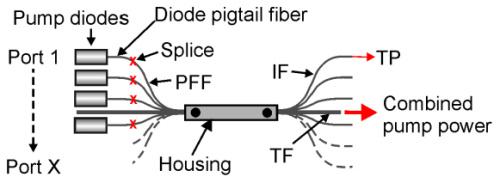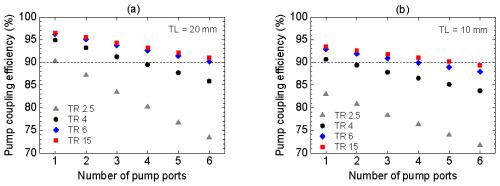Pump and signal combiner for bi-directional pumping of all-fiber lasers and amplifiers(7)
5. Simulations and results for a multi pump port configuration
So far, the modeling results consider a TF with only a single pump port. However, for monolithic high power fiber laser and amplifier systems, it is often required to provide multiple pump ports due to the limited output power of available fiber coupled pump diodes and the efforts to develop laser systems with redundancy. Thus, in this section, we investigate the impact of multiple pump ports on the coupling efficiency and the loss mechanism. The setup of each pump combiner is identical to the description in Section 2 (see Fig. 1), but with several additional ports placed around the cladding of the TF, leading to a fiber bundle. A schematic of a fiber combiner with multiple pump ports is shown in Fig. 7

Fig. 7 Fiber combiner with multiple pump ports, PFF: pump feeding fiber with a piece of coreless intermediate fiber (IF) as described in Fig. 1, TF: target fiber, TP: transmitted power.
5.1 Simulations of the pump coupling efficiency
The experiments and simulations in Section 4 showed that for a pump combiner with a single pump port, a TL of 20 mm and a TR of 6 yields an excellent coupling efficiency in the range of 95%. In comparison, for a fiber band pass filter with multiple pump ports, the simulations for a TL of 20 mm (Fig. 8(a)

Fig. 8 Simulated coupling efficiency for a pump combiner with up to 6 pump ports for (a) a TL of 20 mm and (b) a TL of 10 mm for a pump light input NA of 0.22.
) revealed that the pump coupling efficiency of the combined pump power depends on the number of pump ports and significantly on the choice of the TR. In the simulations the input pump light NA of the PFFs was 0.22. In general, it can be seen that the pump coupling efficiency decreases with each additional pump port. A lower TR yields a greater decrease of the pump coupling efficiency with each additional pump port than a higher TR. In the case of a TL of 20 mm and a TR of 2.5, the theoretically obtainable pump coupling efficiency of almost 90% decreases to 73%, if the number of pump ports increases from 1 to 6. However, as already mentioned, the increasing losses due to additional pump ports can be reduced with increasing TR. In Fig. 8(a) it can be clearly observed that for 6 pump ports and a TR of 6, a pump coupling efficiency of 90.2% can be achieved. For a TR higher than 6, it is not possible to achieve a significant improvement in pump coupling efficiency for multiple pump ports by increasing of the TR.
For a single pump port configuration it is already known that the pump coupling efficiency decreases with shorter TLs at constant TRs (Fig. 2(a)). However, for multiple pump ports a reduction of the TL leads to the advantage that the pump coupling efficiency of the combined pump power decreases less with each additional pump port, especially at lower TRs. The simulation results for a TL of 10 mm instead of a TL of 20 mm are presented in Fig. 8(b). A comparison of Fig. 8(a) and 8(b) shows: If the number of pump ports is increased from 1 to 6 at a TR of 2.5, the pump coupling efficiency experiences a decrease of 16.9 and 11.2% for a TL of 20 and 10 mm, respectively. Although the total power losses for a TL of 10 mm are higher than for a TL of 20 mm, the example reveals, that the decrease of the pump coupling efficiency due to additional pump ports can be reduced by using shorter TLs.
Besides having less available combined pump power, the additional pump power losses generated in comparison to a fiber combiner with a single pump port, corresponds to an enhanced risk of damaging the component due to additional thermal load. Hence, the loss mechanism for a fiber combiner with multiple pump ports needs to be investigated in more detail.
About DK Photonics
DK Photonics – www.dkphotonics.com specializes in designing and manufacturing of high quality optical passive components mainly for fiber laser applications such as 1064nm high power isolator, Cladding Power Stripper, Multimode High Power Isolator, pump combiner,1064nm Band-pass Filter,(6+1)X1 Pump and Signal Combiner, PM Circulator, PM Isolator, optical Coupler. More information, please contact us.